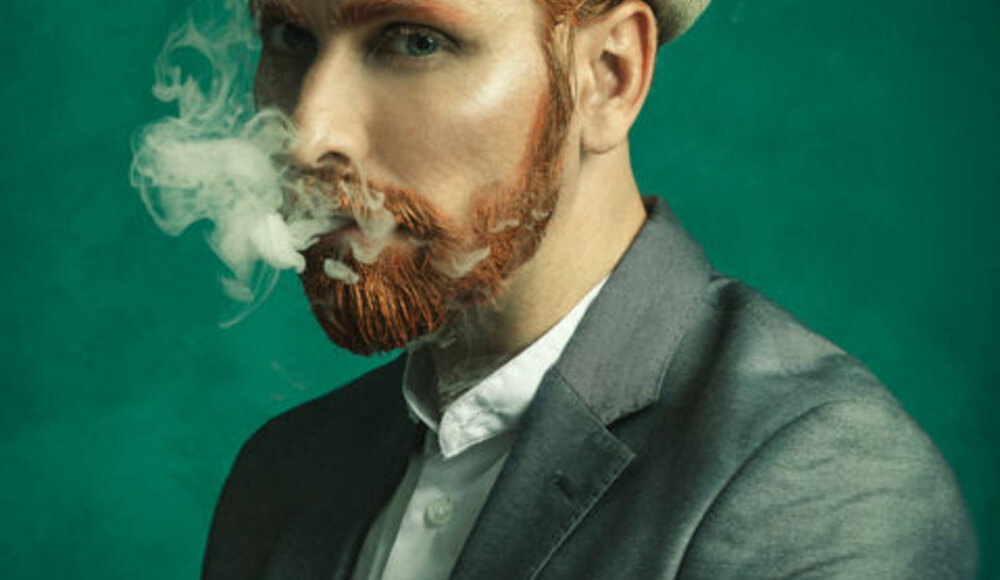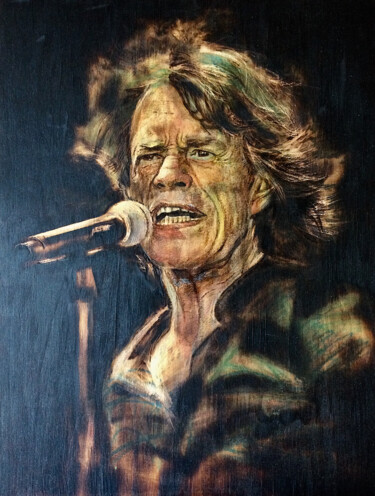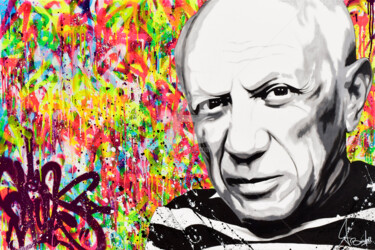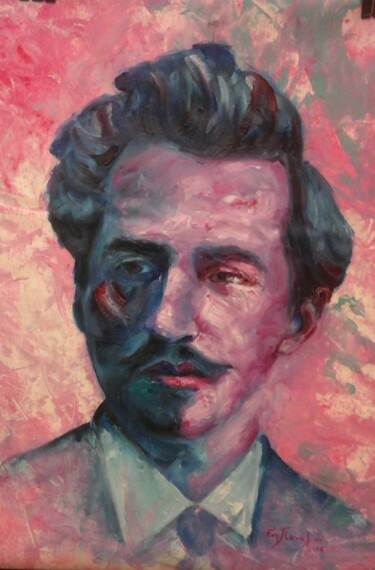 Anastasia Shchurina, 2021, 2021. Painting, Acrylic / Lacquer / Tempera on MDF board, 75 x 55 cm.
Anastasia Shchurina, 2021, 2021. Painting, Acrylic / Lacquer / Tempera on MDF board, 75 x 55 cm.
The genre of self-portrait
The self-portrait is a figurative representation that the artist makes in order to immortalize himself. This artistic genre, which represents a subcategory of the traditional portrait, was born in Italy within the renewal brought by the Renaissance pictorial investigation, inextricably linked to the new anthropocentric conception of the individual. In fact, this new exaltation of the human being led artists to become aware of their role, claiming the importance of their own artistic creation. In this context, the self-portrait became a sort of signature on the production, or rather a tool through which the great masters imposed themselves within their work. This change in the perception of one's own value, and the same desire to emphasize it in front of the public, is evidenced by Dürer's iconic self-portrait (1500), in which the painter painted himself in the likeness of Christ. From this moment on, the history of the self-portrait has crossed the centuries, evolving in styles, in the perspectives of depiction and in the exaltation of psychological introspection, as evidenced by the popular portraits of Titian, Rembrandt, Goya, Van Gogh and Warhol.
 Katalin Macevics, Selfie, 2021. Acrylic on canvas, 59.4 x 42 cm.
Katalin Macevics, Selfie, 2021. Acrylic on canvas, 59.4 x 42 cm.
 Ivaan Hansen, Chippado and the Smartphone Monkey, 2019. Painting, acrylic / Digital print / Digital painting on canvas, 180 x 150 cm.
Ivaan Hansen, Chippado and the Smartphone Monkey, 2019. Painting, acrylic / Digital print / Digital painting on canvas, 180 x 150 cm.
The selfie: the contemporary self-portrait
Every day about 93 million selfies are taken around the world, which, for the most part, are intended to enrich social platforms, with the aim of grabbing a few handfuls of likes. But are we sure that this new trend, apparently very superficial, has not traced deep attitudes, already investigated by the greatest masters of the past? To this question we could answer with an affirmation, just because, the contemporary obsession for the image, it would seem to represent a real form of personal expression, aimed at pursuing the above mentioned intent to celebrate and emancipate its own identity. In fact, already in Dürer's Self-Portrait at Thirteen, made in 1484, the artist had wanted to exalt himself, immortalizing himself in a rather spontaneous and natural way, which turns out to be very close to the trends of our time. Even in the Self-portrait with fur coat, the same master approached the contemporary world, since, highlighting his social status, he anticipated the selfie-ists, who tend to present themselves as unique and distinguished people, flaunting elite goods and attitudes. In addition, self-portraits and selfies, also share the fact that they were born from the idea, or desire, to freeze a meaningful slice of life, despite the fact that, the latter, are often inauthentic. Indeed, selfies are more often than not, constructed, simulated and modified, in order to convey a specific body image, which, rather euphemistic and autosuggesting, is really far from reality. In contrast to the above, Dürer, in his self-portraits, never idealized his outward appearance, but represented it in a literally hyper-realistic way. Finally, even though contemporary selfies are produced with high frequency and often modified, they aim to provide messages similar to those of the most iconic self-portraits, as they act as spokespersons for a desire inherent in human nature, that of documenting one's life, personality, appearance, everyday life and feelings.
 Emilia Amaro, Got to be real. Acrylic on canvas, 80 x 100 cm.
Emilia Amaro, Got to be real. Acrylic on canvas, 80 x 100 cm.
 Emilia Amaro, Do you satisfy?, 2013. Acrylic on wood, 100 x 70 cm.
Emilia Amaro, Do you satisfy?, 2013. Acrylic on wood, 100 x 70 cm.
The self-portrait in contemporary art between remakes, references to the classics and innovation
The work of the artists of Artmajeur is able to provide us with a synthetic and exhaustive snapshot of what the self-portrait represents in the world of contemporary art, a genre often experimented with in order to reinterpret famous masterpieces of the past, refer to the highest tradition and give life to innovative interpretations. In order to illustrate what has been said, reference will be made to the artistic investigation of Mathilde Oscar, Roman Rembovsky and Nikita Van Chagov.
 Mathilde Oscar, Smoking Van Gogh, 2019. Digital photograph, 60 x 40 cm.
Mathilde Oscar, Smoking Van Gogh, 2019. Digital photograph, 60 x 40 cm.
Mathilde Oscar: Smoking Van Gogh
The work of the artist from Artmajeur, Mathilde Oscar, reworks through the medium of photography and, consequently, in an innovatively hyperrealistic manner, Vincent van Gogh's famous self-portrait of 1887-88, entitled Self-Portrait with Felt Hat. The latter painting, conserved at the Rijksmuseum in Amsterdam, represents a decisive stylistic watershed in the work of the Dutch master, since he, who had met Paul Signac in Paris, reinterpreted pointillism, constructing the image through the use of broad, parallel brushstrokes. In addition, even the chromatic range of the artwork turns out to be new to van Gogh, since it, preferring the use of lighter and brighter colors, has clearly suffered the influence of the art of Gauguin and Toulouse-Lautrec. Surely, however, this masterpiece is made iconic also by the serious expression in which the master wanted to portray himself, in fact, he turns to the viewer an intense and melancholy look that, accompanied by a slightly curved mouth, is intended to make explicit his inner drama. It is precisely this palpable suffering that gives the portrait its strong magnetism and emotional involvement, making it unique in its genre. In this context, Oscar's photography appears very close to the original, because the model's gaze rests fixedly on the viewer, even if the mouth concealed by the smoke makes the atmosphere more mysterious than tragic.
 Roman Rembovsky, Self-portrait, 2006. Oil on canvas, 100 x 90 cm.
Roman Rembovsky, Self-portrait, 2006. Oil on canvas, 100 x 90 cm.
Roman Rembovsky: Self-portrait
The artwork of the artist of Artmajeur, Roman Rembovsky, represents a self-portrait of the artist captured inside his studio, a location that is indelibly linked within a vast tradition that includes masters of the caliber of Rembrandt Harmenszoon van Rijn, Francisco de Goya and Amedeo Modigliani. Nevertheless, the attitude of Rembovsky's artistic research seems closer to that of Giorgio de Chirico's Self-Portrait of 1935, in which the Italian artist is immortalized, brush in hand, staring intently at the viewer. In the latter case, however, the master seems almost taken by surprise at the moment in which he was painting, while in Rembovsky's oil the easel appears strangely free of canvas. Probably, the intent of the latter artist is to prefer the celebration of his image, rather than that of his activity. In the same way, de Chirico, in many of his other self-portraits, wanted to exalt his character more, just as in the works made in costume. Finally, the characteristics of Rembovsky's oil place him within the highest tradition of portraiture.
 Nikita Van Chagov, Mentalist self portrait, 2020. Oil on linen canvas, 52.1 x 47 cm.
Nikita Van Chagov, Mentalist self portrait, 2020. Oil on linen canvas, 52.1 x 47 cm.
Nikita Van Chagov: Mentalist self portrait
Finally, as far as self-portraits are concerned, which represent a very personal version of the genre, we can point to the painting by the artist from Artmajeur, Van Chagov, entitled Mentalist self portrait. Just this oil, with a strong surrealist approach, wants to be a characteristic and unique manifesto of the artist's identity, which is revealed in its true robotic nature. This desire to amaze the viewer can also be found in Salvador Dali's Soft self-Portrait with fried bacon, from 1941, which, in the same way, provided an unusual and imaginative version of the artist.


 Olimpia Gaia Martinelli
Olimpia Gaia Martinelli























